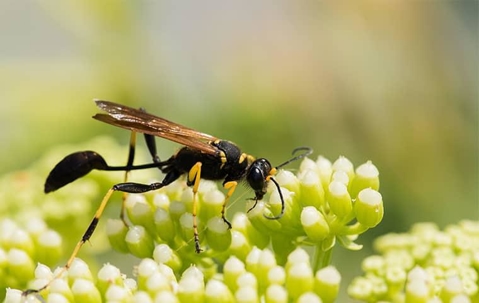Have you ever noticed what looks like muddy, papery tubes under the awnings of your porch or in your garage? You may have spotted the nest of a mud dauber.
Mud daubers are members of the wasp family. But they are not the stinging, swarming wasps you may be thinking of. While normal wasps have a connected head, thorax, and abdomen. Mud daubers look a little odd because they have a petiole, a thread-like waist that attaches the thorax to the abdomen. Mud daubers can come in an array of colors, including blue, black, or yellow. They average about one inch in size.
Unlike wasps, mud daubers are solitary insects. They do not live in colonies and prefer to be off by themselves. Female mud daubers will collect mud to build nests to lay their eggs in. Once the nest is formed, mud dauber females find their prey. With their stingers, the mud dauber females paralyze and preserve their prey for their eggs to eat later. Mud daubers do homeowners in Allen a service by hunting spiders for their larvae. The blue mud dauber, in particular, is known for killing brown and black widows.
Mud daubers are parasitoids, which means that their larvae live as parasites until they eventually kill their host. The female mud dauber will lay her egg on her paralyzed prey. The egg, as it hatches, will consume the prey for food and get nutrients to build its cocoon. The cocoon shields the young mud dauber through the winter months until it emerges from its cocoon and vacates the nest. A mud dauber's diet changes when it becomes an adult. As adults, the mud daubers switch to a vegan diet, drinking from the nectar of flowers.
Homeowners will often find these nests peppered in large holes that the young mud daubers leave behind when they emerge from their nests. The female mud daubers, though, have long since moved on to build more nests.
Mud Daubers vs. Wasps
Mud daubers are less aggressive than many other species of wasps. Wasps, when their working season is over, migrate to human-inhabited areas in search of sweet treats. They will attack humans in response to sudden movement. A wasp sting is painful and can trigger anaphylaxis shock in pets and people. Mud daubers, on the other hand, rarely sting. They are not considered dangerous.
There is a small problem. Other kinds of wasps will sometimes invade a mud dauber's nest in a hostile takeover. When homeowners knock down a mud dauber's nest, they could unknowingly disturb a nest full of angry wasps. To avoid being stung by a swarm of angry wasps, contact Adams Exterminating Company if you find a mud dauber nest on your property. One of our licensed professionals can remove it.
Preventing Mud Daubers
Mud daubers are difficult to prevent. But we have two tips to help you prevent mud daubers.
- Eliminate their food source. Since a mud dauber's diet consists of spiders. A way to prevent mud daubers is to keep spiders away from your home! Sealing up cracks and crevices that spiders can hide in can be effective. Having a comprehensive pest control program will eliminate spiders and all the other creepy-crawly insects in your Allen home.
- Attract mud dauber prey. Several bird species gobble up mud daubers as an appetizer. Homeowners can use birdseed, bird habitats, and birdbaths to attract birds.
If you see signs of mud daubers, contact the professionals at Adams Exterminating Company. Our knowledgeable staff is here to provide advice and assistance to keep mud daubers away from your Allen home.

